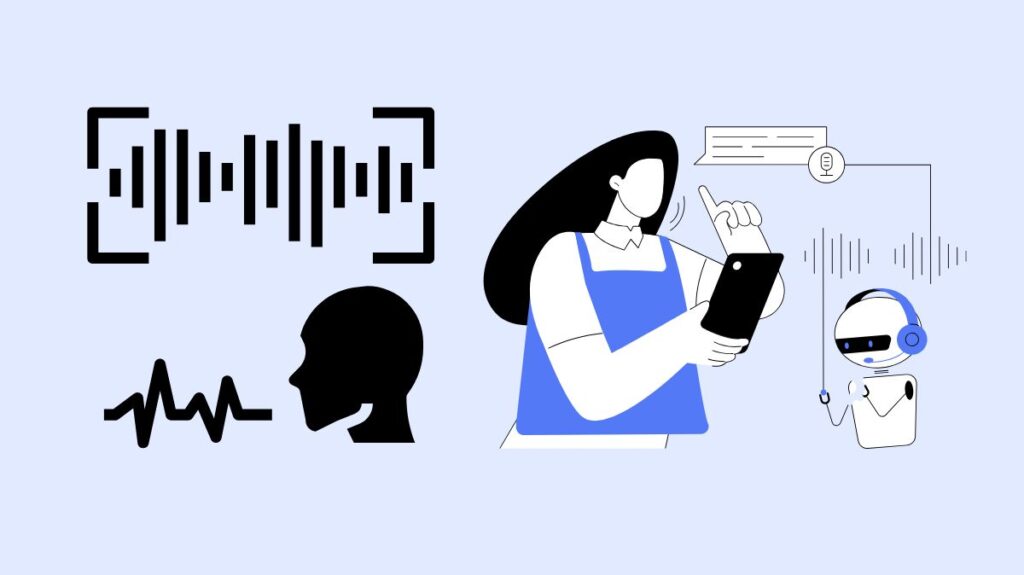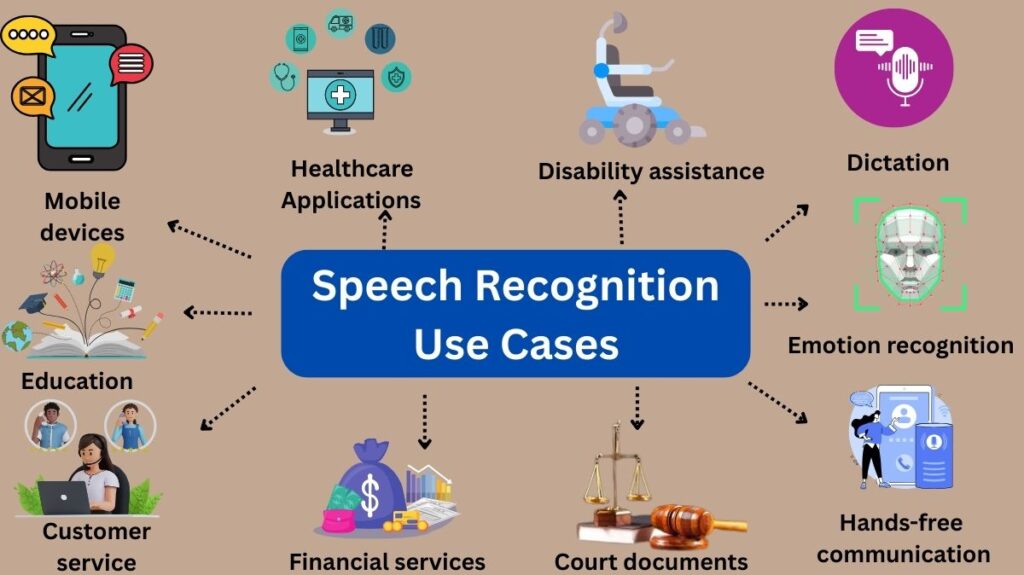Discover what Speech Recognition is, how it works, Speech Recognition Use Cases And Types from virtual assistants to healthcare, customer support, and beyond.
What is speech recognition?

A machine or program that can recognize words spoken aloud and translate them into legible writing is said to have voice recognition, also known as speech-to-text. Because of its small vocabulary, primitive voice recognition software may only recognize words and sentences that are clearly articulated. Advanced software handles accents, natural speech, and multiple languages.
Numerous studies in computer science, linguistics, and computer engineering are used in speech recognition. Many contemporary gadgets and text-focused applications come with speech recognition features to make using a device simpler or hands-free. They are distinct from text-to-speech systems, which work by analyzing text and turning it into audio.
One should not mix voice recognition with speech recognition as they are two distinct technologies.
- Words in spoken language can be identified using speech recognition technology.
- One biometric technique for recognizing a person’s voice is voice recognition.
How does speech recognition work?
Computer algorithms are used by speech recognition systems to process, decipher, and translate spoken words into text. These four processes are how a software program converts the sound that a microphone records into readable language that both computers and people can comprehend:
- Analyze the audio.
- Break it into parts.
- Digitize it into a computer-readable format.
- Use an algorithm to match it to the most suitable text representation.
Because human speech varies greatly and is context-specific, speech recognition algorithms must adjust. A wide range of speech patterns, speaking styles, languages, dialects, accents, and sentence structures are used to train the algorithms in software that translates audio to text. The program additionally distinguishes spoken sounds from the background noise that frequently surrounds the signal.
Speech recognition systems employ two different kinds of models to satisfy these requirements:
- Acoustic models: These show how audio signals and linguistic units of speech are related.
- Language models: To differentiate between similar-sounding words, sounds are matched with word sequences.
Types of speech recognition
One can choose between speaker-dependent and speaker-independent speech recognition software:
Speaker-dependent
These platforms are more precise, but they sacrifice flexibility in the process. First and foremost, the person using the software needs to train them. In doing so, the system is able to identify the distinct speech patterns of the user and continuously enhance the precision of its output. Applications such as transcription and dictation are the most appropriate for this kind of speech recognition software.
Speaker-independent
Such systems are accessible to anyone. A database of generic voice patterns is used to match spoken instructions and queries. These platforms have greater versatility (think interactive voice response or voice-to-text search), but they are more likely to produce erroneous results.
Three different kinds of speech recognition data exist. Each is in line with the input method.
Controlled
The program is able to detect scripted speech, like a menu of standard commands, in a variety of accents and pronunciations. An illustration of such a directive would be “turn off the lights.”
Semicontrolled
The system is given queries and commands that are slightly different in wording with this scenario-based data. “Tell me how to get to the coffee shop,” “give me directions to the coffee shop,” or “tell me the way to the coffee shop” are some examples of numerous ways to ask for directions to a particular location. It requires more robust content analysis prior to response than controlled data.
Natural
This is conversational, unscripted speech like that which is said over the phone. To render correctly, it needs the most sophisticated algorithms and computing power.
Speech Recognition Use Cases
Speech recognition systems have a variety of applications, including:

Mobile devices
Voice commands are used by smartphones for voice calling, speech-to-text processing, voice search, and call routing. Responding to a text message doesn’t need users to look at their smartphones. Apple iPhones, for instance, use speech recognition to operate the virtual assistant Siri and the keyboard. There is also functionality in secondary languages. Additionally, word processing programs like Microsoft Word, which allow users to dictate words to be converted into text, have speech recognition capabilities.
Education
Languages are taught using speech recognition software. The program can hear what the user is saying and provides pronunciation assistance. Students with challenges like deafness or neurodivergence may benefit from these systems.
Customer service
When customers ask questions, automated voice assistants like Amazon Alexa or chatbots listen and point them toward standard resources. While some systems display a list of recommended choices, others ask the user to specify the problem they want fixed. On the other hand, talks between customers and agents can be transcribed using speech recognition software. These conversations can then be examined separately or collectively to find patterns and attitudes.
Healthcare Applications
It can greatly reduce the workload associated with clinical documentation when healthcare providers utilize speech recognition software to transcribe notes into patients’ medical records. In the medical field, accuracy is crucial since a misdialed speech-to-text output may lead to an inaccurate prescription or diagnosis.
Financial services
Whether at a branch office or on a smartphone, bank customers use customer applications, like contact centers or CRMs, to execute transactions. A speech recognition component may be required to teach and authenticate the user’s voice.
Disability assistance
Speech recognition software turns spoken words into text with closed captions or subtitles for hearing-impaired people. Speech recognition lets persons with poor hand function use computers without typing, which speeds up complex systems and workflows.
Court documents
Human transcribers can be supplemented or replaced by software when it comes to courtroom transcription.
Dictation
Speech recognition software allows a speaker to speak into a microphone and produces a transcription of their words exactly. When combined with generative artificial intelligence, digital communication and content production may happen in real time with speed and efficiency.
Emotion recognition
This device determines the emotion a speaker is experiencing by analyzing vocal features. This can show how someone feels about a company, service, product, or other entity when combined with sentiment analysis.
Hands-free communication
Among other things, voice control allows drivers to operate phone features, music, and GPS navigation without touching their phone or the control panel of their car.
